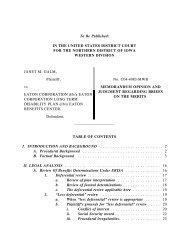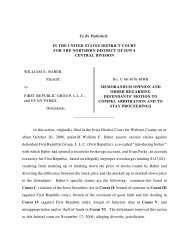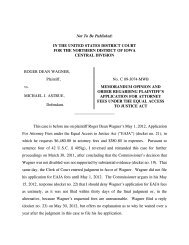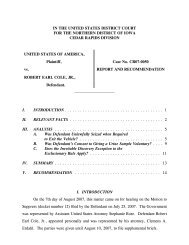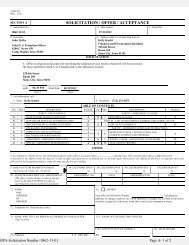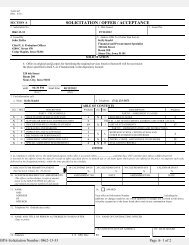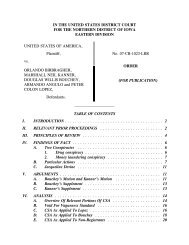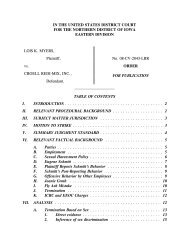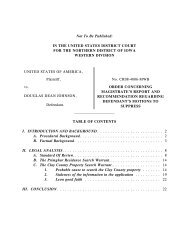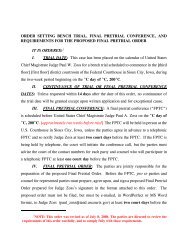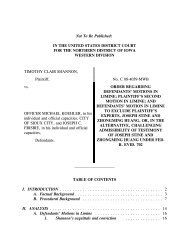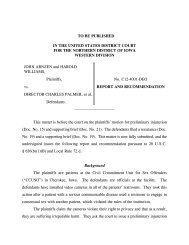C:\Documents and Settings\sey\Desktop\JSS OPINIONS\JSS-05-CV ...
C:\Documents and Settings\sey\Desktop\JSS OPINIONS\JSS-05-CV ...
C:\Documents and Settings\sey\Desktop\JSS OPINIONS\JSS-05-CV ...
You also want an ePaper? Increase the reach of your titles
YUMPU automatically turns print PDFs into web optimized ePapers that Google loves.
secured by equipment which was never purchased by Defendant. Defendant argues that<br />
there is no evidence that he entered into an agreement with Walterman Implement, Inc.,<br />
Leon Walterman, or anyone else to commit a wrong against another as required for<br />
conspiracy. Defendant further argues that he did not engage in the specific conduct<br />
identified by Plaintiff as constituting participation in the alleged conspiracy.<br />
Under Iowa law, “‘[a] conspiracy is a combination of two or more persons by<br />
concerted action to accomplish an unlawful purpose, or to accomplish by unlawful means<br />
some purpose not in itself unlawful.’” Wright v. Brooke Group Ltd., 652 N.W.2d 159,<br />
171 (Iowa 2002) (quoting Basic Chems., Inc. v. Benson, 251 N.W.2d 220, 232 (Iowa<br />
1977)); see also Tubbs v. United Cent. Bank, N.A., Des Moines, 451 N.W.2d 177, 183-84<br />
(Iowa 1990) (“Conspiracy is, basically, a combination of two or more persons to<br />
accomplish, through concerted actions, an unlawful end or a lawful end by unlawful<br />
means.”); Countryman v. Mt. Pleasant Bank & Trust Co., 357 N.W.2d 599, 602 (Iowa<br />
1984) (same). Iowa law also looks to the Restatement (Second) of Torts section 876 to set<br />
the parameters of a conspiracy claim. Wright, 652 N.W.2d at 171-72; Ezzone v. Riccardi,<br />
525 N.W.2d 388, 398 (Iowa 1994). The Restatement provides that: “[A] person becomes<br />
subject to liability for harm caused by the tortious conduct of another when that person:<br />
(a) does a tortious act in concert with the other or pursuant to a common design with the<br />
other (traditional conspiracy). . . .” Ezzone, 525 N.W.2d at 398 (citing Restatement<br />
(Second) of Torts § 876(a), at 315 (1979)).<br />
Additionally, “[f]or conspiracy, an agreement must exist between the two persons<br />
to commit a wrong against another. The agreement must involve some mutual mental<br />
action coupled with an intent to commit the act that causes injury.” Ezzone, 525 N.W.2d<br />
at 398 (citing Adam v. Mt. Pleasant Bank & Trust Co., 387 N.W.2d 771, 773 (Iowa<br />
1986)); see also Doe v. Baxter Healthcare Corp., 380 F.3d 399, 410 (8th Cir. 2004) (“A<br />
civil conspiracy is an agreement between two or more people to commit a wrong against<br />
another person.”). “An agreement sufficient to impose liability results only from a<br />
16



